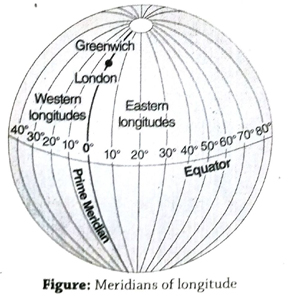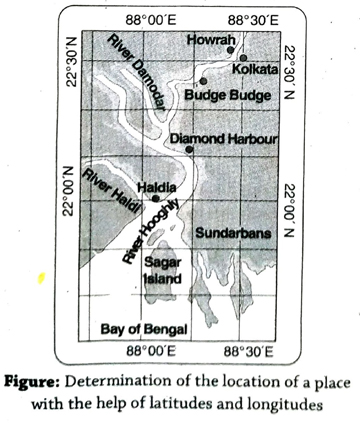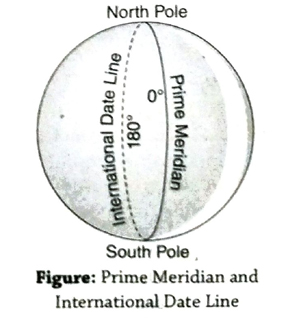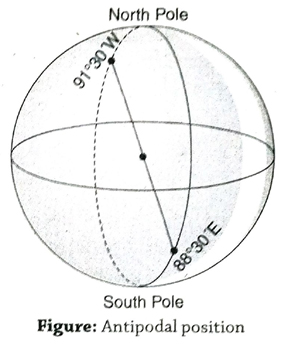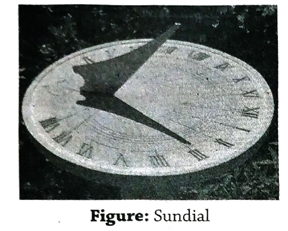WBBSE 9th Class Social Science Solutions Geography & Environment Chapter 3 Determination of Location of a Place on the Earth’s Surface
West Bengal Board 9th Class Social Science Solutions Geography & Environment Chapter 3 Determination of Location of a Place on the Earth’s Surface
WBBSE 9th Class Geography & Environment Solutions
Salient points – At a Glance
- In ancient times, by observing the position of the star in the night sky, the latitude was determined. In the northern hemisphere, latitude can be accurately determined with the help of Pole Star.
- During the day time, latitude of a place can be determined by the angle of inclination of the Sun.
- In the night sky of the southern hemisphere, latitude can be determined by the angle of inclination of the Hadley’s Octant.
- Latitude is the angular distance of a place either north or south of the Equator on the equatorial plane.
- Nowadays, latitudes are determined with the help of Sextant, Transit theodolite, etc.
- Lowest and highest values of latitude are 0° and 90° respectively.
- Parallels of latitude are the imaginary lines drawn on the maps and globes, that join all the places having the same latitudinal value.
- Parallels of latitude are extended in eastwest direction. Amongst them, circumference of the Equator is the largest. Circumference of latitudes decrease with distance from the Equator to Poles. Total number of parallels at an interval of 1° are 179 to the north and south of the Equator.
- The distance between 1º latitudinal interval on the Earth surface is about 111 kms or 69 miles.
- Climate on the Earth surface changes with the change of parallels of latitude. On the basis of climate change, the Earth is divided into 3 heat belts. They are Torrid zone, Temperate zone and Frigid zone.
- The angular distance of a place east or west of the Prime Meridian, that is measured in degree, minute and second is known as longitude.
- The longitude of the Prime Meridian is 0° and the angular distance of other meridians are imagined to the east as well as to the west of the Prime Meridian upto 180°.
- Places with same longitudinal value are joined by semi-circular lines imagined from the North Pole to the South Pole. Such lines are known as Meridians.
- The Prime Meridian (0°) and the 180° meridian, which is the exact opposite side of it, together make a full circle, that divides the Earth into two equal halves. The eastern half is known as eastern hemisphere and the western half is western hemisphere.
- All the meridians are equal in length, but not parallel to each other. This is because, all meridians meet at the Poles.
- There is a 4 minutes time difference for 1° longitudinal difference.
- Considering the maximum inclination of the Sun on a longitude passing through a place as 12 noon, the time of that place throughout the day is calculated. This specific time of that place is called its local time.
- More than one local times are observed in countries with great east-west extension. Therefore, to avoid multiple local times, a meridian is chosen passing through the central position of the country to calculate the standard time of the whole country.
- The Indian Standard Time (IST) is calculated on the basis of the meridian (82°30’E) that extends through Mirzapur of Allahabad.
- Greenwich Mean Time (GMT) is determined according to the Prime Meridian (0°) passing through Greenwich. Time of the whole Earth is determined as per Greenwich Mean Time.
- The time from 12 o’clock at midnight to 12 noon of the next day is called ante meridian or am. The time from 12 noon to 12 o’clock at midnight is called post meridian or pm.
- If the centre of a circle that is drawn on the surface of the Earth and the centre of the Earth lie at same point, then the circle is called Great Circle.
- Parallels of latitude and meridians of longitude intersect each other and form a network, that is called Earth’s grid.
- There are two ends of any diameter of the spherical Earth, where the one end is antipode to another.
- A place and its antipode always lie in opposite hemispheres. This is way, the difference of longitude and local time between these two places are 180° and 12 hours respectively.
- The International Date Line has been imagined through the middle of the Pacific Ocean roughly following the 180° meridian.
TOPIC – A
Latitude and Parallels of Latitude
Long Answer Type Questions
1. What is meant by parallels of latitude? Discuss their properties and their uses.
Ans. Parallels of latitude: The imaginary lines drawn around the Earth parallel to the Equator are known as the parallels of latitude. These lines join all the places with the same latitudinal value.
Properties and uses of the parallels of Latitude: The properties and uses of the parallels of latitude are as follows-
Properties: The properties of the parallels of latitude are- (1) The parallels of latitude are full circles and parallel to each other. (2) As the value of the latitudes increase, the circumference of the parallels of latitude gradually decrease. (3) At the Poles, the parallels of latitude appear to be dots. (4) All places on the same parallel of latitude have the same latitudinal value. (5) Solar incidence changes with changing latitude. Accordingly, the climatic characteristics of the places also vary. (6) The local time of various places lying on the same latitude are different based on their longitudinal value.
Uses: The uses of the parallels of latitude are- (1) The north-south position of a place can be determined by using the Equator and the other latitudes as standards of measurement. (2) The parallels of latitude are often used as the boundary of a country or a state. For instance, the 45° N parallel forms an approximate border between Quebec (Canada), and the states of New York and Vermont in the USA. (3) The Earth can be divided into different heat zones (Torrid zone, Temperate zone and Frigid zone) on the basis of the parallels of latitude.
2. How can you determine the latitude of a place geometrically? How can the latitude of a place in the northern hemisphere be determined using the elevation of the Pole Star?
Ans. Geometric determination of the latitude of a place: In the given picture, B denotes the Earth’s centre, DC the Equator, A the North Pole and P the Pole Star. N is a place in the northern hemisphere with MO as its horizon. Moreover, BQ is perpendicular to MO. As the Pole Star is located vertically above the North Pole, it will be visible at P’ position from N. Consequently, the angle of elevation of the North Star, as visible from N, would be ∠MNP’ and the latitudinal degree of N would be ∠NBC.
Therefore, the angle of elevation of the Pole Star, as visible from N = the latitudinal degree of N.
Using elevation of the Pole Star to determine the latitude of a place in the northern hemisphere: In an open place-two poles, one taller than the other, are fixed. The smaller pole is fixed south of the taller one in such a way that the taller pole is to its north and the Pole Star as visible in the sky, are all in a straight line [Fig (a)]. Now, after measuring the exact distance between the poles, on a white paper the poles need to be drawn to the scale [Fig (b)]. Therefore, in the figure, YR and ZS are the two poles, with RS being the distance between them. Now, Y and Z are joined and simultaneously, SR is extended so that these two meet at the point D and form an angle ∠ZDS. Hence, ∠YDR is the angle of elevation of the Pole Star and also the latitudinal degree. So, if the ∠YDR is measured with the help of a protractor, the latitude of the pla can be determined.
3. Why is it necessary to determine the to determine the location of a place?
Ans. Necessity of determining the location of a place: It is necessary to determine the location of a place, because-
- To find exact position: It helps us to find the exact position of a country, a state, a city, a mountain or any other place on the Earth surface.
- To find the distance: It helps to find the distance between any two or more objects and places.
- For geographical research and study: The location of a place helps us to understand the explanation of any geographical research and study.
- To know climatic character: The climatic characteristics of a place can be known more or less, if the location of the place is known.
- For disaster management: Determination of location is necessary for the relief and rescue management in case of various disasters.
- For transport and navigation: It is necessary to know the location of a place for water transport or navigation and to access resources of particular places.
- For defence purpose: It helps to know the location of enemy for defence or millitary purpose and helps to launch counter attack.
- To demarcate boundaries: Determination of the location is necessary for the demarcation of political boundaries.
- For development plannings: The location of a place also helps us to assign proper development plans for backward regions.
4. How can the Earth be divided into th be divide various heat zones?
Ans. Heat zone: The Earth is divided into three heat zones on the basis of the angle at which the sunrays fall. These are as follows-
- Torrid zone: This zone extends from the Equator (0°) to the Tropic of Cancer (23½° N) in the North and to the Tropic of Capricorn (23½° S) in the South. Sunrays fall vertically on this region throughout the year. Some important countries that fall under this zone are-Brazil, Venezuela, Nigeria, Kenya, Ghana, Malaysia, Indonesia, England, etc.
- Temperate zone: This zone extends from the Tropics (23½° N and S) to the Arctic and Antarctic Circles (66%2° N and S). This zone experiences moderate heat throughout the year because, the sunrays do not fall directly on this zone. Some countries that come under this zone are- United States of America, Chile, France, South Africa, New Zealand, England, Canada, Japan, Germany, Italy and several others.
- Frigid zone: This zone extends from the Arctic and Antarctic Circles (66½° N and S) to the Poles (90° N and S). Frigid zone is the coldest region of the Earth, because this region lies farthest from the Equator and receives very low amount of sunrays throughout the year. Some regions that fall under this zone are-Antarctica, Siberia, Alaska, Greenland, northern Canada, Norway, and the northern parts of Sweden.
Short Explanatory Answer Type Questions Marks 3
1. Why the Equator is known as ‘great circle’?
Ans. When the centre of the circle that is drawn on the Earth’s surface and the centre of the Earth are same, then the circle becomes a ‘great circle’. There are several imaginary lines of latitude drawn over the Earth’s surface and out of those lines, the Equator is known as the great circle, because-
- The largest circle: The Equator is the largest circle. It is not possible to draw a circle larger than the Equator over the Earth’s surface.
- Same centre with the Earth: The centre of the Earth and that of the Equator lies at the same point.
- Divides the Earth equally: If the Earth is divided along the Equator, we get two equal halves. One is northern hemisphere and other is southern hemisphere.
2. Introduce the important parallels of the Earth.
Ans. The important parallels of the Earth are-
- Equator: Value of the Equator is 0°.
Characteristics- The main characteristics of the Equation are- (1) Equator is extended along the middle of the Earth. Its circumference is the largest and it has divided the Earth into two equal halves, so it is called the great circle. (2) Latitude of a place is determined fram the Equator.
- Tropic of Cancer: Value of the Tropic of
Characteristics-The main characteristics of the Tropic of Cancer are- (1) It is the last limit of the northward movement of the Sun and delimits the northern boundary of Torrid Zone. (2) Vertical sunrays fall on this latitude on 21 June.
- Tropic of Capricorn: Value of the Tropic of
Characteristics-The main characteristics of the Tropic of Capricorn are- (1) It is the last limit of the southward movement of the Sun and delimits the southern limit of Torrid Zone. (2) On 22 December, vertical sunrays fall on this latitude.
- Arctic Circle: Value of the Arctic Circle is
Characteristics- The main characteristics of Arctic Circle are- (1) The region between the Arctic Circle and the North Pole experiences 24 hours of day from 21 June for 6 months at a stretch. (2) It is the northern limit of Temperate Zone. (3) After this circle Frigid Zone begins.
- Antarctic Circle: Value of the Antarctic Circle is
Characteristics-The main characteristics of the Antarctic Circle are- (1) From 22 December the region between the Antarctic Circle and the South Pole experiences 24 hours of day for 6 months at a stretch. (2) It is the southern limit of Temperate Zone. (3) After this circle, Frigid Zone begins.
3. ‘The Equator is the most important latitude of the Earth.’ Why?
Ans. The Equator is the most important latitude of the Earth, because-
- Demarcation of hemispheres: The Equator is an east-west extended imaginary line passing through the middle of the Earth. It divides the Earth. into two equal halves as northern hemisphere and southern hemisphere.
- Calculation of latitude: Angular distance or latitude of a place on the Earth is measured from the Equator.
- Drawing of the parallels: All lines of latitude are drawn parallel to the Equator.
- Formation of the Torrid Zone: The sunrays fall vertically over Equator and adjacent areas throughout the year. Thus, these regions form the Torrid Zone.
- Balance of the day and night: Length of days and nights are of equal duration (12hrs) at the Equator, throughout the year. This is because the Equator lies in the middle of the Earth.
4. Why does high temperature prevail in the torrid zone throughout the year?
Ans. The torrid zone extends between the Tropic of Cancer (23½°N) and the ropic of Capricorn (23½° S). The apparent motion of the Sun is also restricted between these tropics. Starting from 22 December to 21 June, the Sun apparently moves from Tropic of Capricorn to Tropic of Cancer, that is known as the apparent northward movement of the Sun. Similarly from 21 June to 22 December, the Sun apparently moves in the opposite direction that is known as the apparent southward movement of the Sun. Therefore, this region receives vertical rays of the Sun throughout the year, and this is why high temperature (25°C-35°C) prevails in this zone.
Short Answer Type Questions
1. What is meant by parallels of latitude?
Ans. The imaginary lines drawn over the Earth, which run parallel to the Equator are known as parallels of latitude. They are also called lines of latitude. These lines join all places having the same latitudinal value or angular distance from the Equator. For example, the Tropic of Cancer (23½° N).
2. What are the properties of the lines of latitude?
Ans. The properties of the lines of latitudes areAll the lines of latitude are full circles and run parallel to each other. They all run in an east-west direction. 3 As the latitudinal value increases, the circumference of the circles of latitudes decreases. The local time of the places lying on the same latitude are always different.
3. What is the Equator?
Ans. The Equator is an imaginary east-west line encircling the Earth midway between the North and South Poles. The Equator is the 0° latitude. It divides the Earth into two equal halves called the northern hemisphere and the southern hemisphere. The average circumference of the Equator is 40,000km.
4. What is meant by equatorial plane?
Ans. The imaginary plane that passes through the Equator and cuts the Earth into two equal halves is called the equatorial plane. The centre of the Earth lies on this plane and so, the angular value of this plane is 0°. It is perpendicular to the Earth’s axis.
5. What is the Arctic Circle and Antarctic Circle?
Ans. Arctic Circle is the parallel of latitude that runs along 66½° north of the Equator, whereas, Antarctic Circle is the parallel of latitude that runs along 66%2° south of the Equator. The region beyond the Arctic and the Antarctic Circles experience 6 months of complete daylight and 6 months of complete darkness throughout the year.
6. What is meant by latitude?
Ans. The angular distance of a place, north or south of the Equator, usually measured in degrees is known as latitude. All the places having the same latitudinal value, joined by a single line, forms the parallel. For example, the latitude of Kolkata is 22° 30′ N.
7. What is meant by angular distance?
Ans. An angle whose apex is at the centre of the spherical Earth and whose legs are radii intersecting the circle in two distinct points, thereby subtending an arc between those two points is known as the angular distance. The unit used to measure the angular distance is degrees, minutes and seconds as it is conceptually identical to an angle.
8. What is a Sextant?
Ans. A Sextant is an instrument used to determine the angle between a celestial object and the horizon (this angle is also known as the object’s altitude). The instrument has an in-built telescope and helps in determining the latitude of a place.
9. What is meant by the northern and the southern latitudes?
Ans. The latitudes can be delineated into two types on the basis of which hemisphere it is located in. They are-
Northern latitudes: Latitudes located to the north of the Equator are known as northern latitudes. So, all the latitudes from 1° to 90° in the northern hemisphere will be marked as northern latitudes. These are denoted by the letter ‘N’.
Southern latitudes: Latitudes located to the south of the Equator are known as southern latitudes. So, all the latitudes from 1° to 90° in the southern hemisphere are the southern latitudes. These are denoted by the letter ‘S’.
10. What is meant by 22°30′ N latitude of Kolkata?
Ans. Latitude is the angular distance of a place from the centre of the Earth either north or south of the Equator on the equatorial plane. Latitudes at the north and south of equatorial plane are known as northern and southern latitudes respectively. Now, the latitude of Kolkata is 22°30’N, which means Kolkata is located at an angular distance of 22°30′ at the north of the Equator.
11. What is the difference between a great circle and small circles?
Ans. When the centre of a circle drawn on the surface of a sphere and the centre of the sphere are same, then the circle is called great circle. The other circles that can be drawn on the surface of a sphere are called the small circles. A great circle is different from small circles, because small circles do not share the same centre with the sphere. For example, the Equator(0°) is a great circle whereas, both the Tropics (23½°) are small circles.
Multiple Choice Type Questions [MCQ type]
Write the correct answer from the given alternatives
1. The highest value of a latitude can be-
A. 90°
B. 100°
C. 175°
D. 180°
Ans. A
2. The total number of latitudes that can be measured at an interval of 1° to the north and south of the Equator are-
A. 189
B. 190
C. 179
D. 181
Ans. D
3. The angular measurement the Arctic Circle is-
A. 60° N
B. 60° S
C. 66° 30′ N
D. 66° 30′ S
Ans. C
4. The angle of elevation of the Pole Star at the North Pole is-
A. 0°
B. 90°
C. 60°
D. 180°
Ans. B
5. The time difference between a place and its antipode is-
A. 6 hours
B. 10 hours
C. 12 hours
D. 24 hour
Ans. C
6. The parallel that runs almost through the middle of West Bengal is-
A. Equator
B. Tropic of Cancer
C. Tropic of Capricorn
D. Arctic Circle
Ans. B
7. The first person to use latitude and longitude to determine the location of a place was-
A. Plato
B. Ptolemy
C. Eratosthenes
D. Aristotle
Ans. C
8. The South Pole is determined by a constellation of stars known as-
A. Pole Star.
B. Morning Star
C. Orion
D. Hadley’s Octant
Ans. D
9. The angular distance of a place, north or south of the Equator, usually measured in degrees is known as-
A. longitude
B. antipode
C. latitude
D. axis
Ans. C
10. The minimum value of a latitude can be-
A. 90°
B. 0°
C. 45°
D. 66½°
Ans. B
11. The northernmost latitudinal extent of India is-
A. 36° 06′ N
B. 97° 25′ N
C. 37° 06′ N
D. 67° 00′ N
Ans. C
12. The total number of parallels of latitude drawn at 1° interval across the globe are-
A. 180
B. 177
C. 178
D. 179
Ans. D
13. The difference in, latitude between the Antarctic Circle and Tropic of Capricorn is-
A. 33°
B. 43°
C. 23°
D. 66°
Ans. B
14. The linear distance between two subequent parallels at an interval of 1° is-
A. 127 km
B. 111.3 km
C. 161 km
D. 164.2 km
Ans. B
15. The angle of elevation of the Pole Star at the Tropic of Cancer is-
A. 0°
B. 23½°
C. 66½°
D. 90°
Ans. B
16. The heavenly body that helps to determine latitude in Australia at night is the-
A. Moon
B. Pole Star
C. Hadley’s Octant
D. Evening Star
Ans. C
17. Any place that is located to the north of the Equator is designated as-
A. high latitude
B. north latitude
C. mid-latitude
D. low latitude
Ans. B
18. The line that joins all the places with the same latitudinal degree is known as the-
A. meridian
B. Prime Meridian
C. parallel
D. Equator
Ans. C
19. At the Equator, the Pole Star can be seen in the-
A. horizon
B. vertically overhead
C. eastern sky
D. western sky
Ans. A
20. The latitude at which the diurnal range of temperature is the lowest is-
A. Equator
B. Tropic of Cancer
C. Tropic of Capricorn
D. South Pole
Ans. A
21. The line in the southern hemisphere that marks the boundary till which vertical sunrays lie is-
A. Equator
B. Tropic of Cancer
C. Tropic of Capricorn
D. Antarctic Circle
Ans. C
22. Value of the highest latitude on the Earth is-
A. 90°
B. 100°
C. 175°
D. 180°
Ans. A
23. Total number of latitudes to the north or south of the Equator at 1° interval are-
A. 89
B. 90
C. 91
D. 180
Ans. B
24. Value of the latitude of the Arctic Circle is-
A. 60° N
B. 66° S
C. 66°30′ N
D. 66°30′ S
Ans. C
25. Angular distance of Kolkata from the centre of the Earth is-
A. 22°30′ N
B. 23°30′ N
C. 60° N
D. 66°30′ N
Ans. A
26. The angle that forms between the equatorial plane and the centre of the Earth is-
A. 60°
B. 90°
C. 0°
D. 22°30′
Ans. C
Very Short Answer Type Questions
Fill in the blanks with suitable words
1. The lines of ……….. run in an east-west direction.
Ans. latitude
2. The latitudinal value of the Tropic of Cancer is ……….
Ans. 23½° N
3. The only great circle among the parallels of latitude is the……….
Ans. Equator
4. The lines of latitude are also known as the …………
Ans. parallels
5. The expanse between the 90° and the 66½° latitudes in both the hemispheres are known as ………..
Ans. frigid zone
6. The heavenly body that helps to determine latitude in the North Pole is the …………
Ans. Pole Star
7. As the angular distance of a place, north or south of the Equator increases, the circumference of the latitude ………
Ans. decreases
8. ……….. divides the Earth into two equal halves.
Ans. Equator
9. The latitudes are …………. in shape.
Ans. circular
10. The latitudes between Equator and 30° in both the hemispheres are known as ………. latitudes.
Ans. low
11. The instrument used to calculate the latitude of any place is …………
Ans. Sextant
12. Latitude of the Antarctic circle is ……………
Ans. 66½°S
TOPIC – B
Longitude and Meridians of Longitude
Long Answer Type Questions
1. What is meant by meridians of longitude? Discuss their properties and their uses.
Ans. Meridians of longitude: In geography, a meridian is the half of an imaginary great circle
on the surface of the Earth, that ends at the geographical poles-the North Pole and the South Pole. It connects all the points of equal longitude. Each meridian is of equal length and is perpendicular to all the circles of latitude.
Properties and uses of meridians of longitude: The Properties and the uses of meridians of longitude are as follows-
Properties: The properties of the meridians of longitude are- (1) All the meridians of longitude are half circles. (2) They are not parallel to each other. (3) The distance between two consecutive meridians is the highest at the Equator, and reduces gradually towards the Poles. (4) All the meridians are of equal length. (5) All places on the same meridian have the same longitudinal degree. (6) The climatic characteristics of the places on the same meridian are not same. (7) The local time of various places lying on the same longitude are always the same.
Uses: The uses of the meridians of longitude are- (1) The east-west position of a place can be determined with reference to the Prime Meridian and the other longitudes as standard of measure. (2) The local time of any place on the surface of the Earth can be calculated based on which longitude it is positioned. (3) Sometimes the boundary of any country or state is demarcated by the meridians. For example, some state boundaries of the USA.
2. Explain with examples how the location of a place can be determined using the lines of latitude and longitude. How does the local time change with changing lines of longitude?
Ans. Determination of location of a place with the help of parallels of latitude and meridians of longitude: The location of any place on the Earth’s surface can be determined by using the lines of latitude and longitude. The parallels of latitude are full circles and run in east-west direction. On the other hand, the meridians of longitude are half circles and run in north-south direction. The combination of these
two components form a graticule that specifies the position of any place on the Earth. This is why both parallels of latitude and meridians of longitude are shown on the map. To determine the exact location of a place, both are essential. For example, location of Kolkata is 22° 30′ N and 88° 30′ E. This statement explains the fact that, Kolkata is located at the intersection point of 22°30′ N latitude and 88°30’E longitude.
Change of the local time with the changing lines of longitude: The lines of longitude of the Earth are half circular lines that extend from north to south. Since the Earth rotates on its axis once every 24 hours, each longitude faces the Sun directly once every 24 hours. When the Sun is directly overhead any longitude, it is noon at that longitude. The local time of that longitude is calculated with reference to noon time at that longitude. Therefore, each line of longitude experiences noon only once every 24 hours and each longitude experiences it at different points of time. That is why local time changes with change in the longitude.
3. What is the International Date Line? Explain the significance of the line.
Ans. Internation Date Line: The International Date Line is an imaginary line that follows the 180° longitude. However, it deviates from its original position near the Aleutian, the Fiji and the Chatham Islands. The International Date Line acts as a divider between the dates of the eastern and the western hemispheres. It is according to this line that the calendar date changes.
Significance of International Date Line: The Earth takes 24 hours or 1440 minutes to complete one rotation of 360°. Therefore, for every 1° difference in longitude, we experience a time difference of 4 minutes. Moreover, since the Earth rotates from west to east, the local time in the east is ahead of the local time in the west. So, if the local time is followed on a world tour, a lot of discrepancies can arise regarding the date and time of the places. This creates a lot of confusion and inconvenience for business purposes.
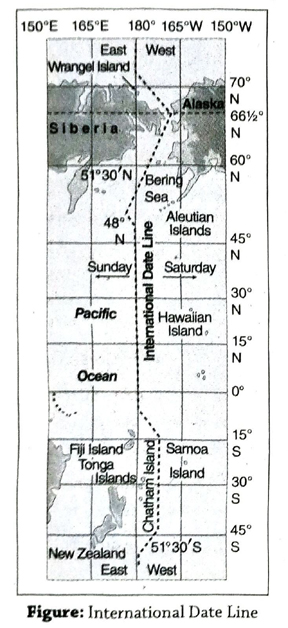
For example, both the 180° E and the 180° W are actually the same line, but the time difference as any aeroplane or ship crosses the line is calculated to be 12hrs + 12 hrs = 24 hrs or 1 day. A suitable solution was provided in 1884 at the International Meridian Conference (IMC), held in Washington DC, that was attended by the representatives of 25 nations. In IMC the 180° meridian was selected as the International Date Line, though it does not follow the 180° meridian throughout. The International Date Line acts as a divider between the dates of the eastern and western hemispheres. The calendar dates are changed according to this line. As anyone crosses the International Date Line from east to west, he subtracts 1 day (i.e., if it was Monday earlier, now it becomes Sunday for him) and adds 1 day (i.e., if it was Sunday earlier, now it becomes Monday for him) as he crosses it from west to east, to keep parity with the time and date of that place.
Short Explanatory Answer Type Questions
1. What do you mean by the Greenwich Mean Time?
Ans. Greenwich Mean Time or GMT is the local time of the 0° Meridian passing through Greenwich near London. As different countries have different standard times, it becomes difficult to carry out international communications. To avoid this problem, Greenwich Mean Time is followed across the globe. Therefore, GMT is also known as the Universal Time. Countries located to the east of the Prime Meridian are ahead of the GMT while those to the west are behind GMT.
2. How can we determine the longitude of a place?
Ans. The longitude of a place can easily be determined with the following references-
- With reference to time of any other longitude: We experience a time difference of 4 minutes, for 1° longitudinal difference. So, if 4 minutes are added to the local time of a place, we get the next longitude, at an interval of 1, towards the east of that place. Similarly, if 4 minutes are subtracted from the local time of a place, we get the next longitude, at an interval of 1, towards the west of that place. Therefore, if the local times of any two places are known along with the longitude of any one place, the longitude of the other place can be easily calculated.
- With reference to GMT: GMT is the local time of the 0° meridian passing through Greenwich near London. This is also known as the Universal Time. So, if the time difference of a place from the GMT is known, the longitude can be easily calculated. Local time is ahead for places to the east and behind for the places to the west of Prime Meridian. E.g., the Indian Standard Time is ahead by 5 hours 30 minutes of GMT Therefore, the longitude of the Standard Meridian of India will be 82° 30′ E.
3. How was the International Date Line determined?
Ans. To use a global time zone system with an International Date Line, the day and date have to be separated at some point on the Earth by marking a terminal point. The suitable solution was provided in 1884 by the International Meridian Conference (IMC), held in Washington D.C., that was attended by representatives of 25 nations. The IMC selected the 180° meridian as this terminal point. The imaginary line of International Date Line was thus drawn that follows the 180° longitude mostly but deviates from its original position near the Aleutian Islands, the Fiji and Chatham Islands. The International Date Line acts as a dividing line between the dates of the eastern and western hemispheres. It is according to this line, that calendar dates are changed.
4. Write a brief note on Prime Meridian and International Date Line.
Ans. Prime Meridian: The Prime Meridian is the imaginary line of longitude, considered to have a value of 0°, which passes through the Greenwich Observatory in London.
Special characteristics: The Special characteristics of Prime Meridian are – (1) This line is directly opposite to the 180° line of longitude or the International Date Line. (2) This line divides the Earth into eastern and wastern hemispheres. (3) As this line passes through the Royal Observatory in Greenwich, London, it is called the Greenwich line. (4) Location and local time of any place are determined with reference to this line. (5) The line is important to know the distance of a place from the Prime Meridian in east-west direction.
International Date Line: The International Date Line is an imaginary line that follows the 180° longitude mostly but deviates from its original position over the landmasses.
Special characteristics: The special characteristics of the International Date Line are- (1) A calendar date starts and ends at this line. (2) When anyone crosses the International Date Line from east to west, he subtracts one day from his calander. Similarly he has to add one day when he crosses the line from west to east.
5. Why do some countries have more than one standard time?
Ans. Places situated on different meridians have different local times. A number of meridians pass through every country. If all their local times are considered then the proper functioning of the administration and business gets hindered. So, to avoid such situation, the local time of the central meridian is taken as the standard time for the entire country. However, countries with a vast east-west extension face problems regarding time difference between its eastern and western parts. Too great a time difference between the extreme east and the extreme west, causes inconvenience and confusion. Therefore, these countries are divided into several time zones, each having its own standard time. For example, Russia is divided into 11 time zones.
6. What do you mean by the Daylight Saving Time or DST?
Ans. In the countries of the high latitudes, the difference between the duration of day and night is quite huge with the changing seasons. Therefore, many countries started using Daylight Saving Time or DST (first proposed by Benjamin Franklin in 1784) to make better use of the natural daylight in the evenings. Many use it to reduce the amount of energy needed for artificial lighting during the evening hours. Many countries in the northern hemisphere, like the USA, Canada, Central America, Europe, Asia, North Africa use DST. Similarly, many countries in the southern hemisphere, like Australia, New Zealand, countires of South America, South Africa also use DST. In the northern hemisphere, from 21 March the countries advance the clock timing by 1-2 hours. Likewise from 23 September the clock is set back by 2 hours to make the best use of the daylight.
7. How are longitude and time interrelated?
Ans. Longitude and time are interrelated in the following ways-
- Determination of midday and local time: Longitude helps in determining the time of midday of any area. The time of midday helps in determining the rest of the time of the day, because each and every longitude of the Earth faces the Sun at least once in 24 hours.
- The difference between each 1º longitude and time is 4 minutes: The Earth takes 24 hours to complete a rotation. So, the Earth rotates 360° in 24 hours. That mean, to complete 1° rotation Earth takes 4 minutes.
- The regions of the east are always ahead in time than those of west: The Earth rotates from west to the east, so the places in the east experience sunrise and sunset earlier than the places in the west. So, the places located in the east are ahead in time than the places located in the west.
8. Write three characteristics of antipode.
Ans. Diametrically opposite places on the Earth surface are antipode to each other. Three characteristics of antipode are-
- Latitudinal value of a place and its antipode always remain same, but the heimspheres are different.
- Longitudinal difference between any place on the Earth and it’s antipode is always 180º.
- If a place lies on the Equator, its antipode will always lie on the Equator and antipode of a place that lies on 180° longitude, will always lie on 0° longitude.
9. How will you reckon the antipode of a place on the basis of longitude?
Ans. Two ends of any diameter of the Earth are antipode to one another. So, the reckoning of the antipode is possible if the longitude of a place is known. As a place and its antipode lie on the diametrically opposite sides of the Earth, the longitudinal difference between a place and its antipode will always be 180°. As an example, longitude of Kolkata is 88°30′ East. So, the longitude of its antipode will be (180° – 88°30′ E) its = 91°30′ West (Refer Figure ‘Antipodal position’ of question number 8 of this section).
10. Determine the difference between a place and its antipode.
Ans. The differences between a place and its antipode are-(1) A place and its antipode are always situated at opposite longitudes. (2) The longitudinal difference between a place and its antipode is always 180°. (3) The time difference between a place and its antipode is always 12 hours. (4) A place and its antipodal place always fie in opposite hemispheres. (5) A place and its antipode always lie at the opposite points of the diameter that passes through the centre of the Earth.
11. Why is the 180° longitude is known as the International Date Line?
Ans. 180° longitude is known as the International Date Line, because- (1) 180° longitude is considered as the starting and ending point of the dates and time on the Earth. (2) Since 180° longitude passes mostly over the waterbodies, the time zones of the continents are not affected. (3) When the 180° longitudinal line is crossed from the western side of the Greenwich, the international date is added by a day. Again, when the 180° longitudinal line is crossed from the eastern side of the Greenwich, international date is substracted by a day.
12. Why does the International Date Line not follow the 180° line of longitude 180° line o throughout?
Ans. The International Date Line almost coincides with the 180° longitude but is not completely the same line. It zigzags to avoid crossing over any landmass. In the northern hemisphere, the International Date Line is displaced eastwards to avoid the Wrangel Island as well as the Chukchi Peninsula on the Russian mainland, and then deviates west to avoid the Bering Sea and also deviates almost 7° to avoid Aleutian Islands. In the southern hemisphere, the International Date Line deviates almost 11° to avoid Fiji, Chatham and such other islands. This makes it convenient for all the people of Siberia to follow the standard time of Siberia, the people of Aleutian Islands to follow the Pacific Standard Time of the USA and Fiji, and the people of Tonga and Chatham to follow the standard time of New Zealand and avoid any kind of confusion.
13. What is meant by great circle?
Ans. When the centre of a circle drawn on the surface of a sphere and the centre of the sphere are same then the circle is known as great circle.
Characteristics: The main characteristics of the great circle are- (1) It is not possible to draw a circle on surface of a sphere greater than the great circle. (2) Centre of the great circle coincides with the centre of the sphere. (3) The great circle divides the Earth into two equal hemispheres.
Example: Amongst the parallels, Equator is the only great cricle. The two opposite longitudes together also form a great circle.
14. ‘A tourist experiences a change of time as he goes round the Earth along the Equator and observes a change of climate as he goes from the Equator to the Poles along the meridian’-Briefly explain the reason.
Ans. Keeping the Sun in front, the Earth is rotating on its axis from west to east direction and the time taken by the Earth to complete one rotation is about 24 hours or 1 day. When a tourist goes round the Earth along the Equator, he has to pass through all the meridians. As for each 1° longitudinal difference time difference is 4 minutes, so the tourist experiences a change of time as he goes round the Earth along the Equator.
On the other hand, the intensity of effective solar radiation gradually decreases from the Equator to the Poles. So, the climate gets colder towards the Poles. That is why change of climate is observed from Equator to the Poles along the meridian.
Short Answer Type Questions
1. What is meant by meridian?
Ans. In geography, a meridian is the half of an imaginary great circle on the surface of the Earth, that ends at the geographical poles- the North Pole and the South Pole. It connects all the points of equal longitude. Each meridian is of equal length and is perpendicular to all the circles of latitude.
2. What are the properties of lines of longitude?
Ans. The properties of lines of longitude are – (1) All the longitudes are half circles. (2) All the longitudes are of equal length. (3) The longitudes run in a north-south direction. (4) The local time of the places lying on the same longitude are always same.
3. What is the Prime Meridian?
Ans. Prime Meridian is the imaginary line drawn from the North Pole to the South Pole that passes through Greenwich and is designated as the 0° longitude. All other longitudes are measured from this line. The Greenwich Meridian divides the Earth into two equal halves-the eastern and western hemispheres.
4. What is meant by longitude?
Ans. The angular distance of a place, east or west of the Greenwich Meridian, usually measured in degrees is known as longitude. the places having the same longitudinal value, if joined by a single line, forms the meridian. For example, the longitude of Kolkata is 88° 30′ E.
5. What is local time?
Ans. The time of a place that is determined according to noon time or when the Sun is directly overhead the meridian passing through that place, is called local time of that place. Local time is also determined using the angle of elevation of the Sun at that place.
6. What is standard time?
Ans. The time of any country that is standardised according to the local time at its Standard Meridian or the longitude passing through the middle of that country, is called standard time. The time of a country can be determined from this.
7. What is meant by antipode?
Ans. The antipode of a point is the point on the Earth’s surface which is diametrically opposite to it. The two points which are antipodal to one another can be connected by a straight line running through the centre of the Earth.
8. What is the International Date Line?
Ans. The International Date Line is an imaginary. line that mostly follows the 180° longitude but deviates from its position near the Aleutian Islands, the Fiji and Chatham Islands. The International Date Line acts as a dividing line between the dates of the eastern and western hemispheres. According to this line, the calendar dates are changed.
9. What is a Chronometer?
Ans. Chronometer is a precise and accurate time keeping device, used to determine the longitude at sea. In 1735, John Harrison built the first Chronometer, which he improved with many innovations, over the next thirty years before submitting it for examination. The most complet international collection of Chronometers, including the Harrison’s, is at the Royal Observatory, in London, England.
10. At which places does the International Date Line deviate from the 180° longitude?
Ans. The International Date Line is not a straight line. It moves in a zigzag manner to avoid crossing through any landmass. In the northern hemisphere, the International Date Line is displaced eastwards to avoid the Wrangel Island and then deviates almost 7° west near the Bering Sea to avoid Aleutian Islands. In the southern hemisphere, the International Date Line deviates almost 11° to avoid Fiji, Chatham and such other islands.
11. What is meant by graticule?
Ans. Graticule is a network or web of lines representing the Earth’s parallels of latitude and meridians of longitude, on which maps are drawn. The combination of these two components specify the position of any place on the Earth. However, it does not consider the altitude or depth of a place.
12. What is the Standard Meridian for India?
Ans. India, lying in the eastern hemisphere, has a vast longitudinal extension i.e., from 68°07′ E to 97°25′ E. The 82%2° E longitude is taken as the Standard Meridian for the country and the local time of this meridian is considered as the standard time for entire India. It is known as the Indian Standard Time (IST). The Indian Standard Meridian (ISM) passes through the city of Allahabad. Therefore, the local time of Allahabad is. taken as the standard time for India.
13. What is a sundial?
Ans. Sundial is the earliest timekeeping device, that indicates the time of a day by the position of the shadow of some object that changes due to the apparent movement of the Sun. As the day advances, the Sun moves across the sky. As a result, shadow of the object also moves accordingly and indicates the passage of time. The flat surface of the sundial is called the dial plate, that is generally made out of materials like wood, stone, metal and such others.
14. Why is standard time more useful for a country than local time?
Ans. A number of meridians pass through every country. If their local times are considered then the proper functioning of the national services like railways, airways, postal department in the country gets hindered. So, a country considers the time of its central meridian or the standard meridian to calculate the standard time for the entire country. This is why standard time is more useful for a country than local time.
15. Why does the local time change with the change of meridian?
Ans. The local time changes with the change of meridian, because- The Earth takes 24 hours to complete one rotation on its axis. So, each meridian of the Earth faces of the Sun once every 24 hours. Midday occurs on a meridian when sunrays fall vertically on that meridian. Local time of that meridian is determined according to this time. So, midday occurs once every 24 hours in each meridian. So, the local time changes with change of the meridian.
16. What are am and pm?
Ans. Local time of any place between midnight or 12 o’clock at night and midday or 12 noon is called ante meridian or am, while the local time of any place from midday or 12 noon to midnight or 12 o’clock at night is called post meridian or pm.
17. What are GMT and IST?
Ans. GMT or Greenwich Mean Time is the local time of the Prime Meridian (0°) that passes through the Greenwich Royal Astronomical Observatory. In the year 1884, by an international agreement, the local time of the Prime Meridian was selected as the standard time for the whole world. So, it is also called the World Standard Time.
IST is Indian Standard Time. The central meridian of India is 82°30′ East that passes through Mirzapur of Allahabad in Uttar Pradesh. The local time of 82°30′ East meridian is granted as the local time of all the places in India.
18. What is time zone?
Ans. Countries with great east-west longitudinal extension have several time zones. Each zone has its own standard time. Thus Russia has been divided into 11 time zones.
Multiple Choice Type Questions [MCQ type]
Write the correct answer from the given alternatives
1. The time difference between Kolkata and Greenwich is-
A. 5 hrs
B. 5 hrs 30 mins
C. 6 hrs
D. 6 hrs 30 mins
Ans. B
2. The time difference between Kolkata and Dhaka is-
A. 20 minutes
B. 30 minutes
C. 40 minutes
D. 50 minutes
Ans. B
3. The antipode of the 180° longitude is located at-
A. 180°E
B. 180°W
C. 0°
D. 90°E
Ans. C
4. For every 1° difference in longitude, there is a time difference of-
A. 4 minutes
B. 5 minutes
C. 6 minutes
D. 10 minutes
Ans. A
5. The difference in local time between Kolkata and Allahabad is-
A. 20 minutes
B. 22 minutes
C. 24 minutes
D. 26 minutes
Ans. C
6. The linear distance between two lines of longitude at an interval of 1° at the Equator measures to-
A. 110.3 km
B. 111.3 km
C. 113.3 km
D. 114.3 km
Ans. B
7. The angular value of the Prime Meridian is-
A. 0°
B. 23½°
C. 66½°
D. 90°
Ans. A
8. The number of time zones in Russia is-
A. 11
B. 9
C. 15
D. 10
Ans. A
9. The instrument used to determine time at Greenwich is called the-
A. Chronometer
B. Anemometer
C. Sextant
D. Thermometer
Ans. A
10. The angle at which the International Date Line deviates near the Aleutian Islands is-
A. 11°E
B. 11°W
C. 7°E
D. 7°W
Ans. D
11. The antipode of 45° N is located at-
A. 180°
B. 0°
C. 45° S
D. 45° W
Ans. C
12. The line that helps to determine the longitude of a place is-
A. Prime Meridian
B. 180° meridian
C. Equator
D. None of the above
Ans. A
13. Highest value of meridian of longitude is-
A. 90°
B. 100°
C. 180°
D. 360°
Ans. C
14. Number of standard meridian in India is-
A. one
B. two
C. three
D. four
Ans. A
15. On crossing the International Date Line from eastern hemisphere to western hemisphere, the time deducted will be-
A. 24 hrs
B. 48 hrs
C. 12 hrs
D. None of them
Ans. A
16. Linear distance of 1° longitude at Poles is-
A. 11.2 km
B. 1.1 km
C. 0.25 km
D. 0 km
Ans. D
17. The clock time at midday is-
A. 12 pm
B. 12 am
C. 12 noon
D. None of the above
Ans. C
18. International Date Line passes through the middle of-
A. Pacific Ocean
B. Indian Ocean
C. Atlantic Ocean
D. Arctic Ocean
Ans. A
19. Distance between two adjacent meridians is maximum at-
A. equatorial region
B. tropical region
C. sub-polar regions
D. polar region
Ans. A
20. The location of a place on the Earth’s surface is determined with the help of-
A. parallels of latitude
B. meridians of longitude
C. parallels and meridians
D. prime Meridian
Ans. C
21. The standard time of India is calculated on the basis of …….. longitude.
A. 80°E
B. 82°E
C. 82°30′ E
D. 88°30′ E
Ans. C
22. The most important line joining the North Pole and the South Pole is the-
A. Equator
B. Tropic of Cancer
C. Polar Circle
D. Prime Meridian
Ans. D
Very Short Answer Type Questions
Fill in the blanks with suitable words
1. The International Date Line coincides with the ………
Ans. 180° longitude
2. The location of any place on the surface of the Earth can be determined by the intersection point of the …….. and the …….. of that place.
Ans. latitude; longitude
3. With every 15° longitudinal difference, there is a time difference of ……… minutes.
Ans. 60
4. ……… is also referred as the International Meridian.
Ans. Prime Meridian
5. The lines of longitude run in a …….. direction.
Ans. north-south
6. The number of time zones that Russia is divided into is ………
Ans. 11
7. ……… is referred as the standard meridian of India.
Ans. 82° 30′ E
8. The longitudes are ……… in shape.
Ans. semicircular
9. The standard time at any place of the world is determined with reference to the ……….
Ans. Greenwich Mean Time
10. All the ………. are equal in length.
Ans. longitudes
11. A time difference of 4 minutes is observed for a longitudinal difference of ……….
Ans. 1°
12. The angular value of the Prime Meridian is ………..
Ans. 0°
13. The longitudinal difference between 90° W and 5° E is ……..
Ans. 95°
14. The standard meridian of the westernmost time zone of the USA is ……….
Ans. 120° W
15. The antipode of the 180° longitude lies on ………..
Ans. 0° (Prime Meridian)
16. The line from which a new date starts in both eastern and western hemispheres is the ………
Ans. International Date Line
17. Each meridian cuts all parallels at ………
Ans. right angles
18. Before and after time of midday are known as ………. and ………. respectively. as
Ans. am, pm
19. According to the various positions of the Sun in the sky, calculation of local time is called ……….
Ans. Sun time
20. The time difference between a place and its antipode is ……….
Ans. 12 hours
If the statement is true, write ‘T’ and if false, write ‘F’ against the following
1. When it is 7 am in Kolkata, it is 12 midnight at its antipode.
Ans. F
2. The International Date Line is not a straight line.
Ans. T
3. The 0° longitude is known as the Prime Meridian.
Ans. T
4. A time difference of 24 hours is experienced with 180° of longitudinal difference.
Ans. F
5. When it is daytime at a place, its antipode experiences night.
Ans. T
6. The antipodal position of a place located on the Prime Meridian will be on 180° longitude.
Ans. T
Answer in one or two words
1. What are lines of longitude also known as?
Ans. Meridians of longitude.
2. What is the Prime Meridian also known as?
Ans. Greenwich Meridian.
3. What is the angular distance of a place, east or west of the Prime Meridian known as?
Ans. Longitude.
4. Which natural object can be used to calculate time?
Ans. Sun.
5. What is the other name of Local Mean Time?
Ans. Solar time.
6. Who invented the Chronometer?
Ans. John Harrison.
7. What is the linear distance between two lines of longitude, at an interval of 1°, along the Equator?
Ans. 111.3 km.
8. What is located at the antipode of the Prime Meridian?
Ans. 180° longitude or the International Date Line.
9. What is the time difference between IST and GMT?
Ans. 5hrs and 30mins.
10. What is the time difference between a place and its antipode?
Ans. 12 hours.
11. What is the longitudinal difference between sa place and its antipode?
Ans. 180°
12. How much time is gained while crossing the International Date Line from the western hemisphere?
Ans. 24 hours or 1 day.
13. When and where was the International Meridian Conference held?
Ans. October, 1884 in Washington DC.
14. Which state of India experiences sunrise first?
Ans. Arunachal Pradesh.
15. Which meridian does follow the International Date Line?
Ans. 180° meridian.
16. What is the antipodal latitude of 30° N latitude?
Ans. 30° S.
17. What is the time difference for 15° meridian difference?
Ans. 60 minutes or 1 hour.
18. What is the satellite system for the determination of elevation and location on the Earth surface called?
Ans. Global Positioning System (GPS).
19. Which country has the maximum number of standard meridians?
Ans. Russia (11).
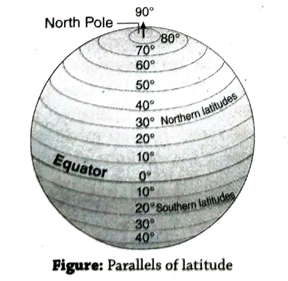
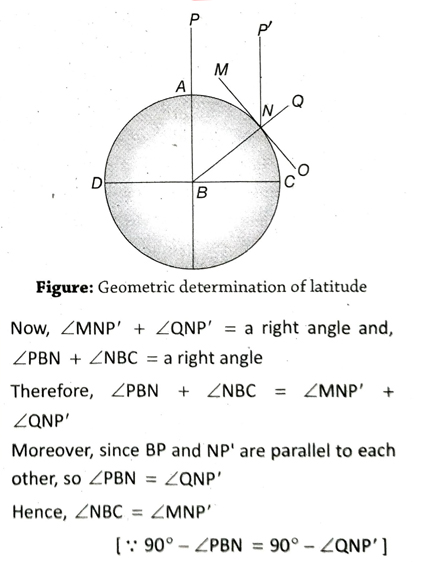
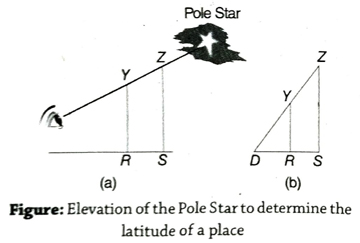
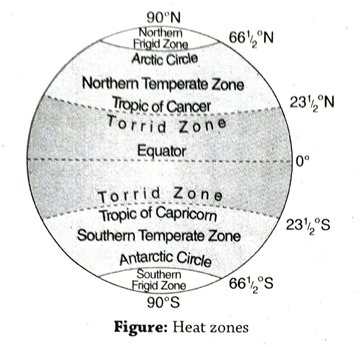
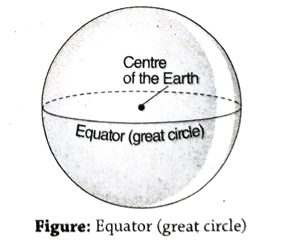
 Characteristics-The main characteristics of the Tropic of Cancer are- (1) It is the last limit of the northward movement of the Sun and delimits the northern boundary of Torrid Zone. (2) Vertical sunrays fall on this latitude on 21 June.
Characteristics-The main characteristics of the Tropic of Cancer are- (1) It is the last limit of the northward movement of the Sun and delimits the northern boundary of Torrid Zone. (2) Vertical sunrays fall on this latitude on 21 June. Characteristics-The main characteristics of the Tropic of Capricorn are- (1) It is the last limit of the southward movement of the Sun and delimits the southern limit of Torrid Zone. (2) On 22 December, vertical sunrays fall on this latitude.
Characteristics-The main characteristics of the Tropic of Capricorn are- (1) It is the last limit of the southward movement of the Sun and delimits the southern limit of Torrid Zone. (2) On 22 December, vertical sunrays fall on this latitude.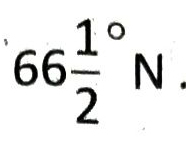 Characteristics- The main characteristics of Arctic Circle are- (1) The region between the Arctic Circle and the North Pole experiences 24 hours of day from 21 June for 6 months at a stretch. (2) It is the northern limit of Temperate Zone. (3) After this circle Frigid Zone begins.
Characteristics- The main characteristics of Arctic Circle are- (1) The region between the Arctic Circle and the North Pole experiences 24 hours of day from 21 June for 6 months at a stretch. (2) It is the northern limit of Temperate Zone. (3) After this circle Frigid Zone begins.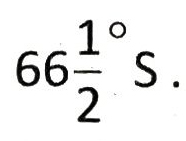 Characteristics-The main characteristics of the Antarctic Circle are- (1) From 22 December the region between the Antarctic Circle and the South Pole experiences 24 hours of day for 6 months at a stretch. (2) It is the southern limit of Temperate Zone. (3) After this circle, Frigid Zone begins.
Characteristics-The main characteristics of the Antarctic Circle are- (1) From 22 December the region between the Antarctic Circle and the South Pole experiences 24 hours of day for 6 months at a stretch. (2) It is the southern limit of Temperate Zone. (3) After this circle, Frigid Zone begins.